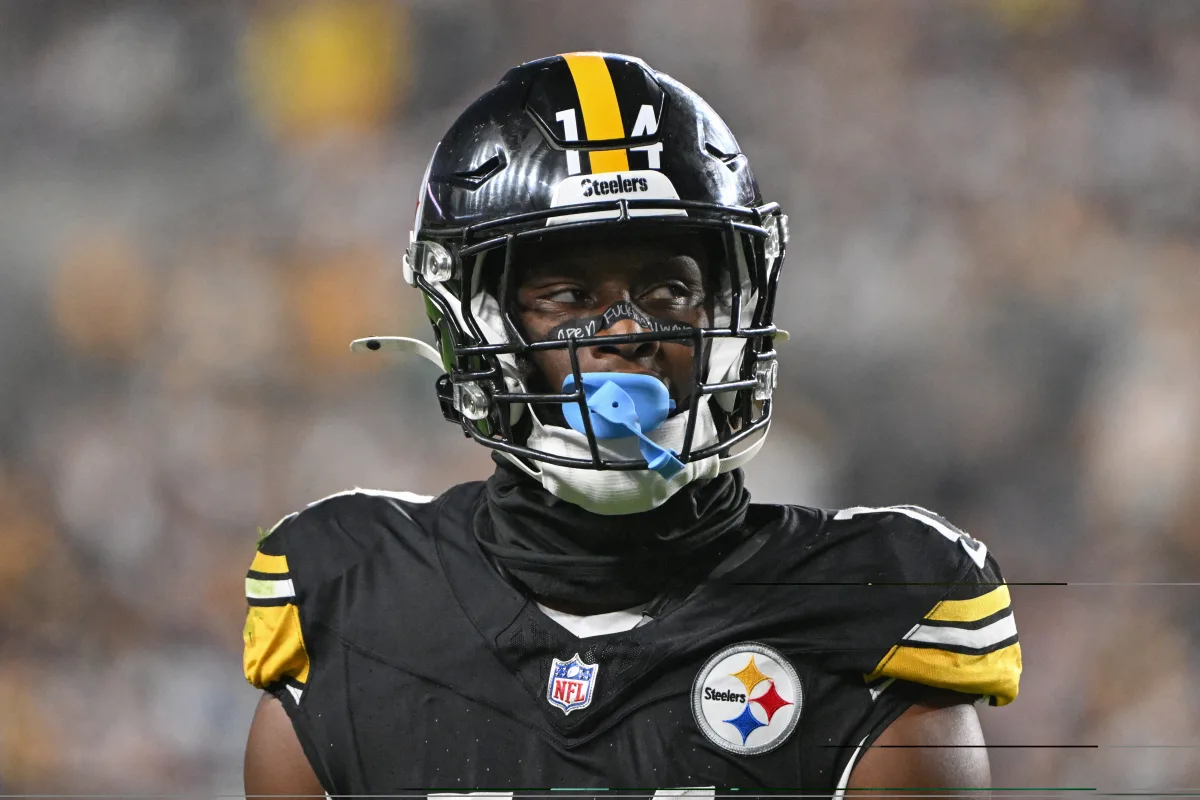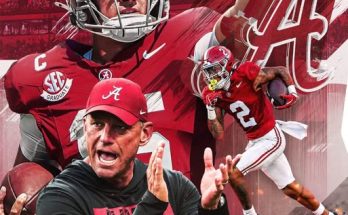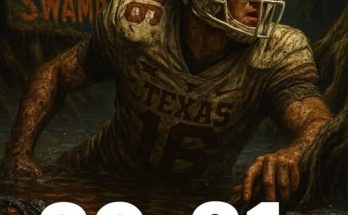The National Football League (NFL) is a league with a strong commitment to maintaining its image and upholding a standard of professionalism both on and off the field. From uniform regulations to conduct codes, the NFL has consistently imposed rules to ensure that the league’s players represent not just themselves but also the broader ideals of the game. One of the latest instances in which the league flexed its regulatory muscle involved Pittsburgh Steelers wide receiver George Pickens, who found himself in the headlines for all the wrong reasons after a profane message was displayed on his eye black during a game in the 2023 season.
Pickens, known for his on-field talent and sometimes fiery demeanor, caused a stir when he wrote a vulgar phrase on his eye black—a piece of equipment worn beneath players’ eyes to reduce glare from the sun. The phrase was a direct, explicit message that quickly went viral, sparking widespread discussion across social media platforms, news outlets, and the NFL community.
This article will dive into the incident itself, the NFL’s response to the situation, the potential reasons behind Pickens’ actions, and the broader implications of this fine on the culture of the NFL and its players. What does this fine mean for Pickens and the broader NFL player conduct code? Was this an overreaction, or is the fine a reflection of the league’s need to maintain control over its public image?
The Incident: A Controversial Message on Eye Black
During a crucial 2023 regular season game between the Pittsburgh Steelers and a division rival, George Pickens caught the attention of fans and media alike not only for his stellar play but for a controversial decision he made prior to the game. Pickens, known for his dynamic ability to make big plays, was seen with a bold and provocative message written on his eye black, a small strip of black adhesive applied beneath a player’s eyes to block out glare.
What made the message controversial, however, was the explicit content. The message, written in large block letters, contained profanity directed toward an unnamed individual. Although the exact details of the phrase were not initially fully disclosed by the Steelers or the NFL, the league acted swiftly to address the issue. Within a matter of days, the NFL fined Pickens $10,000 for violating the league’s policy against inappropriate or offensive messaging in official games.
While Pickens was not the first player in NFL history to use his body or equipment as a means of self-expression, this incident garnered significant attention due to the explicit nature of the message and the NFL’s prompt and firm response. As the story spread, it became a topic of intense debate across the sports world: Was the NFL’s decision to fine Pickens justified, or was it an overreach into the personal expression of its athletes?
The NFL’s Stance on Player Conduct and Equipment Regulations
The NFL has long maintained strict policies regarding its players’ conduct, both on and off the field. Player conduct has always been a central part of the league’s operational framework, with the NFL being very particular about how its players represent themselves, the teams they play for, and the league as a whole.
Uniform Regulations and the Code of Conduct
One of the most visible ways in which the NFL enforces its standards is through its uniform regulations. According to the NFL’s official policies, players are expected to wear uniforms that align with the league’s brand and image. These policies include not only the attire but also the use of equipment like eye black, gloves, and helmets. While eye black is often used for practical purposes—namely, reducing glare—it also functions as a space for players to express themselves.
However, the NFL has rules regarding the messaging on eye black and other equipment. In 2019, the league reinforced that “political statements, personal messages, or anything deemed inappropriate or offensive” were prohibited from being displayed on player gear during games. This rule was likely in response to previous instances where players wrote or wore controversial messages on their equipment, including the 2018 season, when several players used their gear to express political beliefs. While the NFL does allow for some personal expression, it draws the line at anything that could be considered offensive, vulgar, or inappropriate.
The League’s Decision to Fine Pickens
The NFL’s decision to fine Pickens $10,000 came as a result of his clear violation of this rule. The message on his eye black was deemed not only offensive but also disruptive to the league’s public image, especially considering the NFL’s wide audience across various demographics.
While Pickens did not receive any disciplinary action from the Pittsburgh Steelers organization itself, the league was swift in issuing the fine, underscoring that it would not tolerate players using their platform for such messages. Pickens’ fine was widely seen as a reminder that the NFL has a responsibility to uphold a standard of professionalism, particularly in the highly commercialized environment of televised games. In the end, the $10,000 fine was both a warning to Pickens and to other players who might consider using similar messaging in the future.
Pickens’ Reputation and On-Field Performance
Before delving into the broader implications of the fine, it’s important to understand the context of George Pickens as a player. Pickens, who entered the league as a highly touted rookie in 2022, quickly became one of the most dynamic wide receivers in the NFL. Known for his incredible athleticism, impressive catching ability, and tough mentality, Pickens was a key part of the Steelers’ offense in both the 2022 and 2023 seasons.
His early success was met with high expectations, and despite his occasional outbursts, he maintained a reputation as a hard-working and driven player. However, Pickens’ fiery passion on the field has occasionally crossed into controversy off the field. Throughout his career, he has had a few run-ins with the media, and his competitive edge has sometimes been interpreted as arrogance or petulance.
It’s likely that Pickens’ fiery personality contributed to the decision to display a vulgar message on his eye black. While the message’s specific target remains unclear, it was speculated that Pickens could have been responding to a rivalry, a perceived slight, or even a personal issue with an opponent, a coach, or a member of the media. Whether or not the message was justified, the NFL’s response was clear: personal expression has limits, particularly when it risks sullying the image of the league.
The Broader Implications for the NFL
Pickens’ fine is indicative of a much larger issue facing the NFL: the balance between player expression and the league’s desire to maintain a controlled and polished public image. The NFL’s image has been shaped not only by its athletes’ performances on the field but also by how those athletes represent the league off the field. With a vast global fan base, the NFL has always worked to ensure that its players maintain professionalism in all aspects of their lives. This includes their interactions with fans, their actions during games, and the messages they communicate on the field.
Freedom of Expression vs. League Control
One of the main criticisms of the NFL’s fine is the league’s approach to restricting player expression. Many players and fans argue that the NFL’s stringent rules on personal messaging stifle individual freedom. Critics contend that the league should allow its players more autonomy to express themselves, as long as the messages are not overtly harmful or divisive. They argue that athletes like Pickens, who have massive platforms, should be allowed to use their visibility to express their thoughts, feelings, and emotions, especially when it pertains to personal or societal issues.
On the other hand, supporters of the fine argue that the NFL’s stance is necessary to prevent the league from descending into chaos. With over 1,000 players competing in the NFL each season, allowing unrestricted messaging on equipment could lead to a proliferation of inappropriate, divisive, or outright offensive statements. In this sense, the NFL’s efforts to regulate player expression are seen as a way of maintaining control and ensuring that the league remains a place of entertainment, not political or social controversy.
Player Branding and Influence
Another important consideration in the aftermath of this fine is the growing role that personal branding plays in modern sports. Players like Pickens are not just athletes; they are brands in their own right. They have social media followings, endorsement deals, and media appearances that extend beyond the football field. As a result, players are increasingly aware of the influence they wield. The problem, however, arises when athletes use this influence in ways that may conflict with the interests of the league or their teams.
In a time when athletes are becoming more vocal about societal issues, the NFL’s decision to fine Pickens could be interpreted as part of a broader attempt to control how players use their platform. As social media continues to play an ever-bigger role in sports, the NFL finds itself at a crossroads: How can it manage the balance between encouraging player expression and protecting the league’s broader interests?
Pickens has since publicly apologized for the incident, acknowledging that the message was inappropriate and acknowledging that he understood the fine was part of the league’s rules. While the situation may have been resolved, the broader implications of the fine will likely continue to resonate for months and years to come.
It remains to be seen how other players will respond to the incident, and whether it will spark broader discussions about personal expression and league policy. The NFL will likely continue to evaluate how to strike a balance between allowing its players to express themselves and maintaining the brand image of the league. What is clear, however, is that this fine—coupled with the controversy it sparked—has shed light on the complex relationship between athletes, personal expression, and league control.



